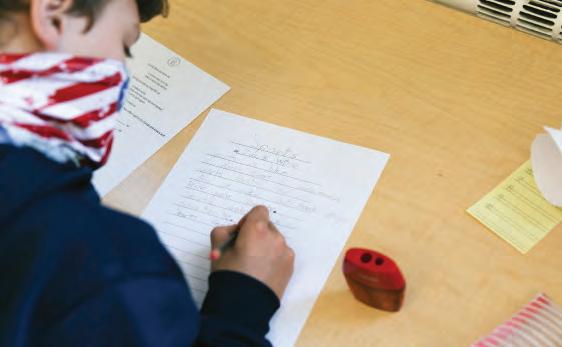
4 minute read
Language Arts
Literacy
Our students begin their journey in literacy by developing a love of story. Reading and writing happens everywhere in the curriculum. We want each child to experience success and confidence in learning to read and write.
Advertisement
In their kindergarten year, students began composing, reading, and writing their own stories. By the end of that year, students decode patterned and simple phonetic texts. They learn to form letters carefully and accurately. They develop phonological and phonemic awareness through songs, rhymes, and games. Play-based phonics instruction allows students to connect symbols and sounds in preparing for reading.
In first grade, students are actively involved in learning phonics and word-solving strategies as they decode words and read more challenging books. They complete a number of writing projects such as writing “how to” books and friendly letters.
Second and third grade students expand on this foundation, developing stamina as they read and write increasingly complex texts, both fiction and non-fiction including biography, poetry, fairy tales. Reading and writing become avenues for research and communicating their understanding. Third grade students also learn how to write summaries and critically answer questions about texts.
Visits to the school library and a summer reading list are also part of the literacy program to nurture the love of reading and keep students engaged with reading outside school.
The balanced literacy program used in the Lower School is composed of units of study from Fountas and Pinnell’s Phonics and Guided Reading program and Teachers College Reading and Writing Project as well as the multi-sensory approach to learning letter formation presented in Handwriting Without Tears.
Reading
FIRST GRADE
Students are guided and exposed to reading in many forms throughout the school day.
• The day begins with students hearing a story in worship. Read-alouds are scattered throughout the morning and afternoon, developing a love of story and increasing student vocabulary, comprehension, and complex thinking skills.
• Daily phonics instruction gives students the building blocks to decode words.
• Small-group reading instruction allows teachers to target students’ individual reading levels and goals. Students utilize phonetic knowledge to decode words and engage in analytic discussions about texts.
• Students additionally engage in independent reading daily, allowing them to practice skills they are learning with a book of their choice.
• Students attend to phrasing and punctuation as they develop the ability to read fluently.
Students read literature and informational texts, and they begin to use reading as a tool as they engage in further research and study.
SECOND AND THIRD GRADE
Reading instruction occurs in a workshop approach with small groups meeting and reforming into different groups as students gain skills. The teacher can design groups based on skills assessed and target instruction to a student’s goals and level. Within this format teachers provide:
• Specific phonetic instruction to support decoding and encoding,
• Feedback about the quality and content of students’ reading,
• Strategies for improving decoding, comprehension, and fluency,
• Increased time and longer texts to support stamina for sustained reading,
• Prompts and questions for students to reflect in writing about their reading and prepare them for discussion,
• Opportunities to share their work with peers and teachers.
Students continue to read a range of texts that are literature and informational. Phonics and word recognition continue to be part of reading instruction as students gain a larger sight-word vocabulary and decode multisyllabic words.
Writing
FIRST GRADE
First grade students learn the writers’ process which includes prewriting, drafting, conferencing, revising, and publishing. Students learn to write with purpose as they work with research, non-fiction, and personal narrative forms of writing. They learn how to write topic sentences and add details to sentences. Throughout the year they increase the amount of writing they can complete, adding more sentences as their skill and stamina increases.
Through phonetic word study, students begin to recognize patterns in words and apply them to their reading and writing. Towards the end of the year, they advance in skill to write words with more standardized spelling. They learn conventional forms of punctuation in simple sentences.
GRADES TWO AND THREE
Students continue working through the steps of the writing process (prewriting, drafting, conferencing, revising, publishing.) and gain the habits of good writing. They cycle through drafts and focus on traits of writing: voice, organization, word choice, sentence fluency, and conventions. Through reading exemplar texts, students note the craft of various writers and use them as mentor texts for their own writing. They begin to apply learning in science and social studies to produce writing pieces that express their understanding. Students are expected to write and sustain independent writing for 10 to 15 minutes.
Word study expands as students master blends, digraphs, prefixes, suffixes, vowel combinations, and strategies for multisyllabic words. They develop standardized spelling of an expanding list of high frequency words. Mechanics, usage, and conventions are layered into the work of the year as students grow as writers.
“What can the Viking culture, which is often characterized by pillaging and conquests, teach us about life, learning, and community? In first grade, children begin to consider their own role as explorers of the world, tellers of stories, participants in conflict, and people who are challenged to build a community using shared (and sometimes very limited) resources. We can begin to make judgments about right and wrong by examining a culture that had flaws and strengths.
First grade is a time for taking heroic risks and making courageous choices. For many, learning to read, write, or speak in front of classmates is a risky endeavor! A study of the Vikings helps us discover our hopes for our own community and how we experience and explore the world around us together.” — First Grade Teacher, Kate Streelman






